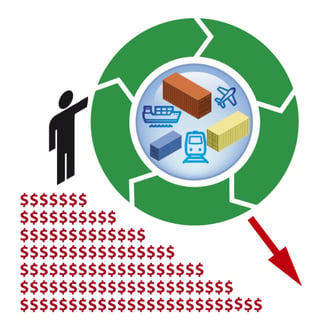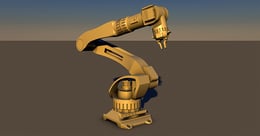Does Integrated Planning Reduce Transport Costs?
Nick Ostdick - September 26, 2017

 It’s a question each and every manufacturing company grapples with: How can we reduce our transport costs and attempt to normalize our transportation strategy given the number variables associated with shipping our products? In an industry like manufacturing where so much of how efficiency a company functions is dependent on getting the right product to the right customer at the right time in the right condition, transport logistics cannot be overlooked as a critical part of the value chain.
It’s a question each and every manufacturing company grapples with: How can we reduce our transport costs and attempt to normalize our transportation strategy given the number variables associated with shipping our products? In an industry like manufacturing where so much of how efficiency a company functions is dependent on getting the right product to the right customer at the right time in the right condition, transport logistics cannot be overlooked as a critical part of the value chain.
But as companies work to create and deploy transport logistics strategies to optimize transportation platforms and reduce costs on the backend of the production cycle, there are actually opportunities for transport optimization at the front end of the production cycle, particularly when it comes to integrated planning. Essentially, companies that implement integrated planning strategies early in the production cycle can actually experience significant competitive advantages later in the cycle when it comes to move products from the shop floor to the customer’s door.
Moving away from error-prone planning platforms like Excel spreadsheets and other manual data input and management methods makes for more effective planning and production programs, which in turn makes it easier to allocate resources for more accurate transport solutions. Optimized solutions and integrated planning software offer companies the ability to reduce the likelihood of supply chain bottlenecks and increase inventory flexibility through trend analysis, past demand reporting, forecasting, and simulation capabilities. This also makes for more accurate planning when it comes to working through transport scenarios.
All this begs the question: How does integrated planning reduce transport costs? What elements of integrated planning enhance transport logistics? With this in mind, let’s examine how transport logistics reduce transportation costs and increase the efficiency of transport logistics.
Trend analytics and pattern recognition
Analytics and reviews of efficiency are key for companies in leveraging the benefits of integrated planning. Isolating spikes and dips in warehouse holdings, transportation volumes, and container inventory are key to implementing a planning strategy for the upcoming year, and intelligent planning software allows planners to conduct in-depth reviews and generate simple, integrated reporting to increase supply chain transparency and reduce overall costs. In addition, trend analysis capabilities provide suppliers the ability to coordinate their planning efforts with different segments of the company – transportation, warehouse, and container management – and help create more seamless and consistent workflows.
But trend analysis capabilities can extend beyond the confines of traditional supply chain logistics to include a number of external factors that impact the supply stream. These analytics can offer manufacturers and suppliers great insight into industry-wide buying trends, which will help streamline all points of the supply stream. A report last year from Reutersi ndicated the current global decline in gasoline and oil prices sparked a significant increase in automotive sales last December throughout much of North America, and many economists believe this strong uptick in sales will continue throughout much of 2016. The ability to monitor this trend and produce predictive models on future fluctuations in the demand for trucks and other industrial vehicles can be crucial to manufacturers and suppliers ensuring enough product to successfully and promptly fill orders and ensure on-time delivery.
Referencing previous demand
Product shortages or overages are quickly becoming less and less palatable for customers in today’s marketplace. Because modern manufacturing takes place on a global stage with a vast array of network partners and major players, companies have to cut through more complexity to achieve enhanced visibility and agility. As such, the margin for error relative to late deliveries and errors in product quantity is becoming slimmer and slimmer. Repeat instances of either can result in severe losses in productivity, revenue, and growth. The ability to reference past demand for products is essential in ensuring these products ship and are delivered on-time and in the correct quantities. Integrated planning software also helps increase the visibility and transparency for past demand across an entire company, allowing for a more collaborative, coordinated effort in creating consistent, synchronized planning. The more individuals with access to a company’s past demand data, the more capable that company will be in creating accurate and efficient forecasting.
Enhanced forecasting and simulations
In such a complex industry, it would stand to reason the ability to forecast future planning and production programs based on analytics, prior customer demand, and potential market forces would be a critical function for planners and managers in an integrated planning platform and to help reduce transport costs. Forecasting capabilities via intelligent planning software can also be useful in establishing sales and supply chain benchmarks to help promote and encourage a company’s organic growth. Establishing such benchmarks and creating an accurate prediction of supply and sales over an upcoming span of time better equips a company to determine how and where to best allocate sales, shipping, container and warehouse resources to eliminate waste and increase communication across a variety of positions.
In addition, the ability to run simultaneous simulations for a variety of potential supply chain bottlenecks is a value-added proposition for any manufacturing company looking for methods of increasing visibility and transparency across a variety of platforms, while at the same time reducing costs and increasing communication and collaboration in a cross-organizational manner. Through an intelligent planning system, planner and managers can input such an occurrence into a simulation, incorporating the accompanying variables, to help identify, analyze, and solve supply chain delays or breakdowns.
LATEST POSTS
- Understand Circular Economy in The Manufacturing Industry
- How Can Industry 4.0 IT Integration Be Achieved Smoothly?
- The Significance of Order Sequencing in Discrete Manufacturing
- How to improve your Supply Chain Management: The Power of Control Towers
- Optimizing Human Resource Scheduling in Manufacturing: A Technological Approach



